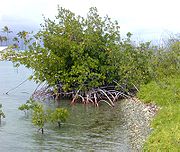
Dominance (ecology)
Encyclopedia

Community (ecology)
In ecology, a community is an assemblage of two or more populations of different species occupying the same geographical area. The term community has a variety of uses...
, or makes up more of the biomass
Biomass
Biomass, as a renewable energy source, is biological material from living, or recently living organisms. As an energy source, biomass can either be used directly, or converted into other energy products such as biofuel....
. Most ecological communities are defined by their dominant species.
Examples
- In heathlandHeath (habitat)A heath or heathland is a dwarf-shrub habitat found on mainly low quality acidic soils, characterised by open, low growing woody vegetation, often dominated by plants of the Ericaceae. There are some clear differences between heath and moorland...
the dominant species are characteristically one or more species of heatherCallunaCalluna vulgaris is the sole species in the genus Calluna in the family Ericaceae. It is a low-growing perennial shrub growing to tall, or rarely to and taller, and is found widely in Europe and Asia Minor on acidic soils in open sunny situations and in moderate shade...
or related plants. - In many examples of wet woodlandWoodlandEcologically, a woodland is a low-density forest forming open habitats with plenty of sunlight and limited shade. Woodlands may support an understory of shrubs and herbaceous plants including grasses. Woodland may form a transition to shrubland under drier conditions or during early stages of...
in western EuropeEuropeEurope is, by convention, one of the world's seven continents. Comprising the westernmost peninsula of Eurasia, Europe is generally 'divided' from Asia to its east by the watershed divides of the Ural and Caucasus Mountains, the Ural River, the Caspian and Black Seas, and the waterways connecting...
, the dominant tree is alder (Alnus glutinosa). - In temperateTemperateIn geography, temperate or tepid latitudes of the globe lie between the tropics and the polar circles. The changes in these regions between summer and winter are generally relatively moderate, rather than extreme hot or cold...
bogBogA bog, quagmire or mire is a wetland that accumulates acidic peat, a deposit of dead plant material—often mosses or, in Arctic climates, lichens....
s, the dominant vegetation is usually species of SphagnumSphagnumSphagnum is a genus of between 151 and 350 species of mosses commonly called peat moss, due to its prevalence in peat bogs and mires. A distinction is made between sphagnum moss, the live moss growing on top of a peat bog on one hand, and sphagnum peat moss or sphagnum peat on the other, the...
moss. - On Earth, arguably, a large amount of its land ecosystems are dominated by human beings, making human beings the ecologically dominant species over much of the planet.
- TidalTideTides are the rise and fall of sea levels caused by the combined effects of the gravitational forces exerted by the moon and the sun and the rotation of the Earth....
swamps in the tropicsTropicsThe tropics is a region of the Earth surrounding the Equator. It is limited in latitude by the Tropic of Cancer in the northern hemisphere at approximately N and the Tropic of Capricorn in the southern hemisphere at S; these latitudes correspond to the axial tilt of the Earth...
are usually dominated by species of mangrove (RhizophoraceaeRhizophoraceaeRhizophoraceae is a family constituted by tropical or subtropical flowering plants. Among the better known members are mangrove trees of the genus Rhizophora...
) - Some sea floor communities are dominated by brittle starBrittle starBrittle stars or ophiuroids are echinoderms in the class Ophiuroidea closely related to starfish. They crawl across the seafloor using their flexible arms for locomotion. The ophiuroids generally have five long slender, whip-like arms which may reach up to in length on the largest specimens...
s. - Exposed rocky shorelines are dominated by sessileSessility (limnology)In limnology, sessility is that quality of an organism which rests unsupported directly on a base, either attached or unattached to a substrate. It is a characteristic of vegetation which is anchored to the benthic environment. There are two families of sessile rotifers: Flosculariidae and...
organisms such as barnacleBarnacleA barnacle is a type of arthropod belonging to infraclass Cirripedia in the subphylum Crustacea, and is hence related to crabs and lobsters. Barnacles are exclusively marine, and tend to live in shallow and tidal waters, typically in erosive settings. They are sessile suspension feeders, and have...
s and limpetLimpetLimpet is a common name for a number of different kinds of saltwater and freshwater snails ; it is applied to those snails that have a simple shell which is more or less conical in shape, and either is not spirally coiled, or appears not to be coiled in the adult snails.The name limpet is most...
s.
See also
- National Vegetation ClassificationNational Vegetation ClassificationNational Vegetation Classification could refer to:* the British National Vegetation Classification * the United States National Vegetation Classification Standard...
, a system for classifying BritishGreat BritainGreat Britain or Britain is an island situated to the northwest of Continental Europe. It is the ninth largest island in the world, and the largest European island, as well as the largest of the British Isles...
plant communities by their dominant species

